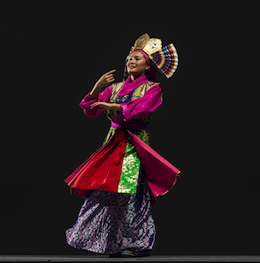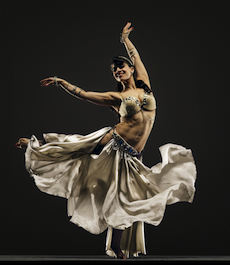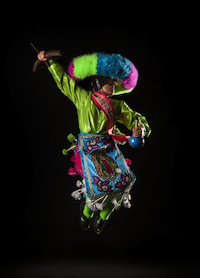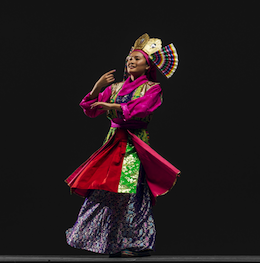If there were a thousand words in this review, it still couldn’t encompass the number of unique descriptions, titles, place names and styles that make up the San Francisco Ethnic Dance Festival. How terrific.
It’s the one time every year — this is the Festival's 35th — that even seasoned dancegoers encounter work they’ve never seen before, but would love to see again. Saturday’s afternoon show at the Lam Center spotlighted 10 troupes, all resident in the Bay Area, and all showing music and dancing that’s definitely from out of town: the Andes, Tibet, the Philippines, Peru, India, Mexico, Bali, the Middle East, and Senegal.

There are two more weekends of shows, each with different companies. If you go, pick up a copy of the attractive program, which costs $2, benefits the festival — which is in need of dough — and will add immeasurably to your understanding and enjoyment of the goings-on. Which are pretty wonderful. It’s rare that you get an opportunity to see companies, chosen by audition, performing for love of their community and their homeland, and their joy Saturday afternoon was contagious.
Colectivo Anqari’s parade of musicians and dancers in the 19th-century Mistiskuri tradition from Bolivia and Peru kicked things off in festive form. Wearing bright shirts and woollen caps with earflaps (ch’ullus; maybe you’ve seen the headwear on the ski slopes), the musicians drummed and played panpipes called sikus. The twirling dancers wore flowered hats and skirts of red and pink. Directed and choreographed by Luis Valverde, the dancers and musicians flowed down the aisles and onto the stage.
Chaksam-Pa, based in California for 25 years, performed a Tibetan purification dance, adapted for the stage as a blessing. Rarely seen outside Southeast Asia, Ache Lhamo opera is on the UNESCO Performance Heritage list. The male singers wore flat blue masks, bearing suns, moons, and wish-fulfilling jewels; drums and cymbals accompanied their high-pitched chants. The women dancers, in sumptuous robes and headdresses bearing sacred images, curved their arms gracefully and moved gently.

Parangal Dance Company offered a show-stopping Philippines wedding celebration from Mindinao. Created by Eric Solano, in a series that included dances for women in silk robes, with sinuously curving wrists; a secret meeting between the engaged couple; an intense martial arts fight with knives and poles and kicks, including elements contributed by Indonesian, Malaysian, and Chinese immigrants to the Philippines, and an amazing performance of the traditional bamboo pole dance called Singkil, where dancers’ ankles dodge the slamming poles in the nick of time. Capping it was the bride’s arrival under wraps, in a sedan chair. She was revealed in a glory of white and gold brocade to her waiting prince and subjects beneath canopies of turquoise and fluttering flags, and everyone danced on to a happy ending.
For something completely different, El Tunante, from Peru, presented a couples’ dance, La Marinera Nortena, choreographed by Nestor Ruiz, that included two pairs of charming children as well as their elders. The marinera, Peru’s national dance, has three styles, and this one, from the north, is both dignified and warm, accompanied by a vocalist, Marina Marchena, and two drummers. Elements similar to Spanish flamenco-style dance are noticeable throughout, executed by high-stepping men in boots and barefooted women.
Two venerable guest artists from India, kathak master Pandit Birju Maharaj and Saswati Sen, led off a performance by the Tarangini School of Kathak Dance, whose swirling, stamping, graceful students, swathed in gold and purple, have studied the art form for 10 years or more. The piece they danced, Mere Dholna, My Beloved, choreographed by Anuradha Nag, is set to a Bollywood love song.

Ballet Folklorico Mexicano de Carlos Moreno’s Guerrero, dance and song from the coast, included dances evoking bullfights, ballrooms, vultures, and finally — intriguingly — iguanas, where the men dancers slithered acrobatically across the floor like break dancers. The music, or Son, derives from indigenous, African and baroque Spanish music; the choreography is by Carlos and Lisa Moreno.
Gamelan Sekar Jaya, from Berkeley, presented wonderful music, with a rather minimal amount of Balinese choreography titled Tari Gabor that left this onlooker wanting more.
Honoring glitz and glamor, according to the program, Shabnam Dance Company, led by Shabnam Sirvani, a group of modern bellydancers, dazzled. Swathed in pearls and golden costumes and chandelier earrings and, once, a headful of lighted candles, flexing their bare midriffs and other integuments, they were sinuous, sexy and athletic all at once. Furthermore, they played the drums called tablas, traditionally reserved for men.
The afternoon romped toward a close with De Rompe Y Raja Cultural Association, whose Afro-Peruvian roots encompass the intricate footwork called zapateo, along with the zamacueca and a marinera in an Afro-Peruvian dance party, Ritmos Negros Del Peru, or Black Rhythms of Peru, choreographed by Gabriela Shiroma, a lively urban mixture of street parade, dance, and song evoking a free people. The instruments included the box drum, or cajon; the quijada, or donkey jaw, with loose teeth shaken or scraped, and the cajita, a box with a lid that’s sometimes lit inside, like a church collection box, and is slammed open and shut.
The loudest drumming of the day and the most exuberant, knees-up dancing came last, with Cheikh Tairou M’Baye and Sing Sing Rhythms, from Senegal, West Africa. Now based in Oakland, this vivacious drum and dance company of Wolof griots, or storytellers, was born in Medina, Senegal, in 1987. A suite of dances choregraphed by Cheikh Tairou M’baye and Babacar M’baye celebrated newborn children (Barra M’baye), improvisations to rhythm (Bak) and honored Senegal’s best dancer, who was also a great cook (Thiebou Djeune). The title refers to Senegal’s national dish of marinated fish; the dancing was supremely tasty, and the audience dove right in, clapping along.

